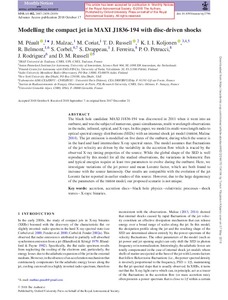Modelling the compact jet in MAXI J1836-194 with disc-driven shocks
M. Péault; J. Malzac; M. Coriat; T. D. Russell; K. I. I. Koljonen; R. Belmont; S. Corbel; S. Drappeau; J. Ferreira; P. O. Petrucci; J. Rodriguez; D. M. Russel
Modelling the compact jet in MAXI J1836-194 with disc-driven shocks
M. Péault
J. Malzac
M. Coriat
T. D. Russell
K. I. I. Koljonen
R. Belmont
S. Corbel
S. Drappeau
J. Ferreira
P. O. Petrucci
J. Rodriguez
D. M. Russel
OXFORD UNIV PRESS
Julkaisun pysyvä osoite on:
https://urn.fi/URN:NBN:fi-fe2021042822833
https://urn.fi/URN:NBN:fi-fe2021042822833
Tiivistelmä
The black hole candidate MAXI J1836-194 was discovered in 2011 when it went into an outburst, and was the subject of numerous, quasi-simultaneous, multi-wavelength observations in the radio, infrared, optical, and X-rays. In this paper, we model its multi-wavelength radio to optical spectral energy distributions (SEDs) with an internal shock jet model (ISHEM; Malzac 2014). The jet emission is modelled on five dates of the outburst, during which the source is in the hard and hard intermediate X-ray spectral states. The model assumes that fluctuations of the jet velocity are driven by the variability in the accretion flow which is traced by the observed X-ray timing properties of the source. While the global shape of the SED is well reproduced by this model for all the studied observations, the variations in bolometric flux and typical energies require at least two parameters to evolve during the outburst. Here, we investigate variations of the jet power and mean Lorentz factor, which are both found to increase with the source luminosity. Our results are compatible with the evolution of the jet Lorentz factor reported in earlier studies of this source. However, due to the large degeneracy of the parameters of the ISHEM model, our proposed scenario is not unique.
Kokoelmat
- Rinnakkaistallenteet [27094]
